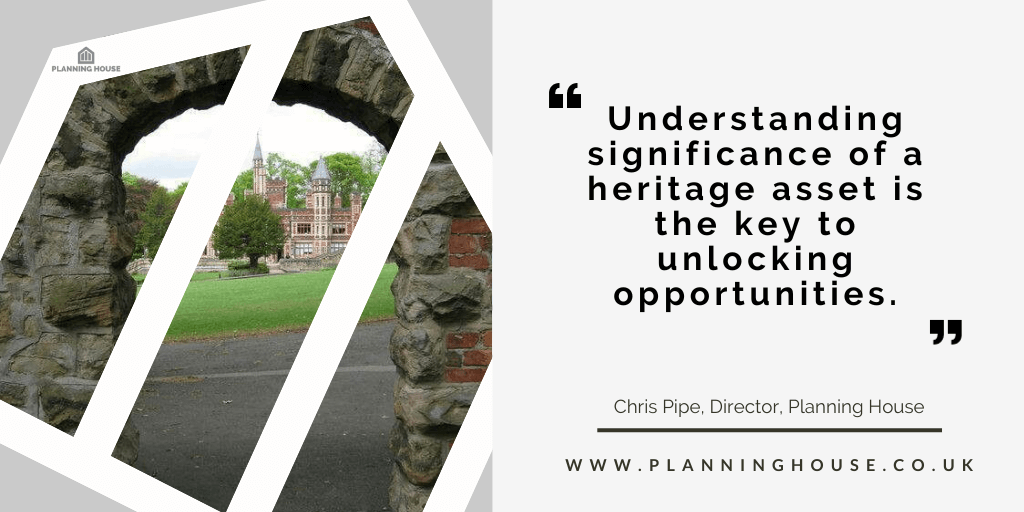The rules around developing in proximity to heritage assets can seem daunting at first, but understanding significance is the key to unlocking opportunities while avoiding unnecessary restriction. Let’s break it down and see how considering significance leads to win-win solutions.
What is a Heritage Asset?
To start, the National Planning Policy Framework (2023) defines a heritage asset as “A building, monument, site, place, area or landscape identified as having a degree of significance meriting consideration in planning decisions, because of its heritage interest.”
In plain English, this includes any property or area designated for its historic value like listed buildings, conservation areas, scheduled monuments, registered parks and gardens, and archaeological remains.
Defining Significance
Central to heritage decisions is determining the asset’s “significance”. Simply put, significance refers to the value or meaning of an asset due to its heritage qualities such as:
- Architectural merit: Materials, construction methods, decorative details;
- Historic associations: With important people or events;
- Aesthetic value: Makes an important contribution to local character; or
- Archaeological potential: May contain buried remains revealing history
By thoroughly researching an asset’s physical attributes, roles in history, and position within its setting, one can build an evidence-based case for its cultural or social significance. Documenting this clearly early avoids debates later on.
Defining Harm
Development affecting the setting of an asset requires an assessment of whether it causes “harm” to its significance. Harm does not preclude development but means impacting on those qualities which make the asset significant. According to the Framework, the main types of harm that can occur to the significance of a designated heritage asset are:
Substantial harm (or total loss of significance of a designated heritage asset)
This is harm that would severely damage the heritage asset’s significance. This may include demolishing or destroying all or part of the asset, development that results in long-term or permanent damage to significant heritage fabric or features, or causing severe or more than minor damage to the asset’s setting.
Less than substantial harm
This is harm that falls short of being substantial, and would have a minor or moderate impact on an asset’s significance. This could include alterations that have a noticeable impact but do not fundamentally change our ability to appreciate its significance.
Where a development would lead to less than substantial harm to a heritage asset the proposal may be justified if the public benefits of the proposal significantly outweigh the harm.
Avoiding Harm
With care taken to understand significance upfront, opportunities often exist for sympathetic schemes. Features like scale, massing, materials and site layout can be designed sensitively. Creative solutions balancing new uses with heritage protection frequently satisfy all parties. An open dialogue engaging local expertise helps identify nuanced solutions respecting both development aspirations and the asset’s heritage values.
How to identify significance?
Here are some suggestions for how developers can engage local expertise to help identify nuanced solutions that respect both development goals and heritage values:
- Reach out early to the local planning authority’s conservation/listed building officer. They can offer guidance on significance and suggest ways to minimize harm.
- Consult heritage groups and local historical societies. They often have a wealth of knowledge about an area’s history and can suggest design options respecting streetscapes or important views.
- If the site has archaeological potential, involve a professional archaeologist to inform layout/foundation designs. Early surveys can find flexibility.
- Consider engaging with an architectural/heritage expert advisor. They know preservation best practices and can mediate discussions to mutual benefit.
- Discuss plans with immediate neighbors and the wider community to understand local attachment and address concerns through design.
- Arrange a site visit with stakeholders to get collaborative input on site-specific merits and limitations in real-world context.
- Be open to phased/mixed use schemes or alternative viable uses that better integrate with heritage aspects.
- Where possible, restore rather than replace historic building fabric to maximize public and planning authority goodwill.
Can a proposal harm an area but not its significance?
It’s possible for a development to harm the character of an area even if it doesn’t directly impact the significance of individual heritage assets or the conservation area as a whole.
Some ways this could occur:
- The development is out of scale or use of inappropriate modern materials that are visually jarring compared to the historic context. This can erode the overall aesthetic cohesion.
- It disrupts important views, vistas or skylines that contribute to the historic character but aren’t formal heritage attributes.
- Traffic, noise or environmental impacts compromise the intact historic ambiance and setting experienced in the conservation area.
- Gradual incremental changes accumulate over time that individually may seem minor but collectively diminish distinctive character-defining elements.
- Architectural quality is poor and fails to respect or complement prevailing styles/forms even if heritage assets aren’t directly impacted.
- Demolition of a non-designated building still decreases historic building density and grain.
So in assessing potential character harm, decision-makers may look broader than just direct impacts on heritage assets or identified significance. Things like context, scale, design quality and secondary impacts are also relevant to preserving the overall historic character of a conservation area.
Related Content
Heritage is a tricky issue in town planning, we’ve compiled a Collection all about heritage which includes case studies, Practical Guides to Listed Buildings and Conservation Areas.
If you’re progressing with a planning application, take a look at our eBook on Application Process for more details on the planning process.
Looking for a Town Planner take a look at our blog When to Hire a Town Planner, which also has a download on Steps to Choosing a Town Planner.
Historic England provides general advice about conservation areas and other heritage assets.


